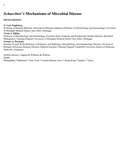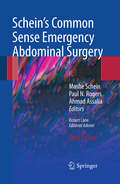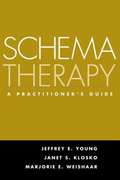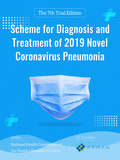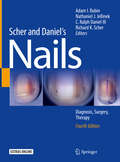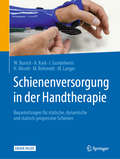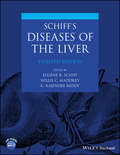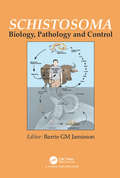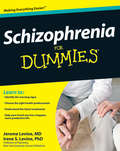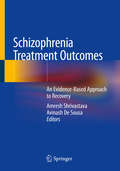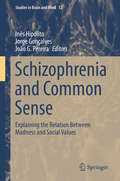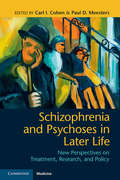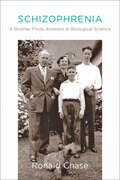- Table View
- List View
Scentwork for Horses
by Rachaël DraaismaScentwork for Horses is the first practical guide on how to implement scentwork into the lives of domesticated horses, enhancing behaviour, welfare, and the human-animal bond. Scentwork is a new discipline in the field for horse and handler, and expert author Rachaël Draaisma arms the reader with a pallet of information to enable them to put this technique into action. As well as theoretical background information on the nose of the horse and biomechanics, Draaisma discusses how scentwork improves horses’ learning abilities, development, socialisation, and their bond with the handler. Readers will learn how to have their horses explore their environment, participate in scentwork games and follow a footstep track to find a missing person or food bag. Easily accessible for anybody working with horses at any level, scentwork can be done in small areas as well as in larger spaces on various surfaces. Whether veterinarian, behaviourist, trainer, animal-assisted therapist, equine physiotherapist, osteopath, or interested horse owner, this book promises to bring both you and the horse enormous benefits, strengthening the human-animal bond. Rachaël Draaisma has always lived with and had a passion for dogs and horses. In 2002, she decided to make it her profession. Achieving several diplomas, she started to work full time as a trainer and behavioural consultant, first with dogs, later with horses. Her best-selling book Language Signs and Calming Signals of Horses, published by CRC Press in 2017, has been translated into several languages. Another pillar of Draaisma’s working life with horses revolves around equine mental stimulation and scentwork, and she has developed an extensive method to undertake scent tracking with horses, a new tool in enriching the human-equine relationship. Draaisma travels throughout Europe and the globe to provide workshops and lectures on calming signals of horses, equine mental stimulation, and scentwork. You can purchase scent bags to aid your scentwork practice at the author's personal website: www.scentworkforhorses.com or www.calmingsignalsofhorses.com
Schaechter's Mechanisms of Microbial Disease
by N. Cary Engleberg Terence S. Dermody Victor DiRitaSchaechter's Mechanisms of Microbial Disease provides students with a thorough understanding of microbial agents and the pathophysiology of microbial diseases. <p><p> The text is universally praised for "telling the story of a pathogen" in an engaging way, facilitating learning and recall by emphasizing unifying principles and paradigms, rather than forcing students to memorize isolated facts by rote. The table of contents is uniquely organized by microbial class and by organ system, making it equally at home in traditional and systems-based curricula. <p><p> Case studies with problem-solving questions give students insight into clinical applications of microbiology, which is ideal for problem-based learning.
Schalm's Veterinary Hematology
by K. Jane Wardrop Douglas J. Weiss Marjory B. Brooks Kendal E. Harr Davis M. SeeligSCHALM’S VETERINARY HEMATOLOGY An updated guide to veterinary hematology with expanded coverage on a variety of topics The revised seventh edition of Schalm’s Veterinary Hematology is updated to provide a comprehensive review of all topics related to disorders of the blood in animals. Designed as a gold-standard reference, this text covers a wide range of species in both confined and free-range populations, reflects the most recent trends in hematology diagnostics, and discusses recent advances in traditional techniques. Edited and written by an international team of experts in the field, the book represents an accessible yet in-depth resource for information on veterinary hematology. The new edition includes a hemolymphatic tissue section that covers current understanding of basic science and the species-specific hematology section is further expanded from previous editions. New chapters address emerging topics in hematology, and existing chapters have been revised and rearranged to improve readability and simplify access to the material. This seventh edition: Updates the most complete reference on veterinary hematology across species Contains a new section on basic biology of hemolymphatic tissues Expands coverage of species-specific hematology Presents new and emerging topics in blood disorders and diagnostic techniques Features a reorganized contents list for an integrated, easy to use reference Written for veterinary clinical pathologists and residents, diagnostic laboratory staff, internists, and specialists, Schalm’s Veterinary Hematology is the most comprehensive and up-to-date reference on the topic.
Schalm's Veterinary Hematology
by K. Jane Wardrop Douglas J. WeissThe long-awaited Sixth Edition of Schalm's Veterinary Hematology has been revised and reorganized to increase accessibility and cohesiveness of the text. Topics are grouped within established disciplines in hematology, and outlines are now included at the beginning of each chapter. The book features new sections on Hematotoxicity and Quality Control and Laboratory Techniques, and includes expanded sections on Laboratory Animal Hematology, Species Specific Hematology, and Hematologic Neoplasia. With in-depth coverage on all aspects of the field, this comprehensive reference is an essential purchase for veterinary clinical hematologists, internists, and students.
Scham 4.0: Exploration einer Emotion in digitalen Welten und der Vierten Industriellen Revolution
by Elisabeth Vanderheiden Claude-Hélène Mayer Paul T. P. WongDieser Sammelband bietet neue Perspektiven darauf, wie das Gefühl Scham in digitalen Welten und in der Industrie 4.0 erlebt und verändert wird. Die Herausgeber*innen und Autor*innen diskutieren, wie Individuen und Organisationen Scham am Arbeitsplatz, in beruflichen und privaten Kontexten und im Hinblick auf soziokulturelle Lebensstilveränderungen konstruktiv transformieren können. Die Beiträge in diesem Band ermöglichen es Forscher*innen und Praktiker*innen gleichermaßen, das Thema Scham und seine Spezifika in einer hochdynamischen und sich schnell verändernden Zeit zu erschließen. Das Verständnis für diese Emotion im Zusammenhang mit Home Office, automatisierten Realitäten und smarten Systemen oder digitalisierten Lebens- und Arbeitsstilen wird vertieft. Durch den Einsatz transdisziplinärer und transkultureller Perspektiven erörtert der Band darüber hinaus Scham im Kontext neuer Lebensstile, Religion, Geschlecht, sexueller Unterdrückung und psychischer Erkrankungen. Forscher*innen, Praktiker*innen und Studierende aus den Bereichen Arbeits- und Organisationspsychologie, Positive Psychologie, Organisationsforschung, Zukunftsforschung, Gesundheits- und Arbeitswissenschaft, Therapie und Beratung, Emotionswissenschaften, Management, Führung und Personalwesen werden die Beiträge als hochaktuell, aufschlussreich und praxisrelevant empfinden.
Schein's Common Sense Emergency Abdominal Surgery
by Paul Rogers Schein Moshe Robert Lane Ahmad AssaliaEmergency Abdominal Surgery is a battleground for the surgeon - providing character-building experiences, and opportunities for triumph and disaster. In the third edition of this 'simple' book, emergency abdominal surgery is discussed in an informal and no nonsense fashion - as practiced in the 'trenches' of the ER and the OR. The preferred approach for a given situation is discussed in context; it has to fulfill certain prerequisites: save lives, decrease morbidity, be cost effective and be performed correctly.
Schema Therapy: A Practitioner's Guide
by Janet Klosko Jeffrey YoungDesigned to meet the formidable challenges of treating personality disorders and other complex difficulties, schema therapy combines proven cognitive-behavioral techniques with elements of other widely practiced therapies. This book--written by the model's developer and two of its leading practitioners--is the first major text for clinicians wishing to learn and use this popular approach. Described are innovative ways to rapidly conceptualize challenging cases, explore the client's childhood history, identify and modify self-defeating patterns, use imagery and other experiential techniques in treatment, and maximize the power of the therapeutic relationship. Including detailed protocols for treating borderline personality disorder and narcissistic personality disorder, the book is illustrated with numerous clinical examples.
Scheme for Diagnosis and Treatment of 2019 Novel Coronavirus Pneumonia: The 7th Trial Edition
by National HealthCommissionofthePeople'sRepublicofChinaAn epidemic of a novel coronavirus emerged from Wuhan, China, in late December 2019 and has since spread to other parts of China and several foreign countries. The 2019 novel coronavirus (2019-nCoV)pneumonia, which is believed to be an acute respiratory infectious disease, has been included among the Class B infectious diseases stipulated in the Law of the People’s Republic of China on the Prevention and Control of Infectious Diseases, and measures for prevention and control of Class A infectious diseases have been adopted for this disease. Thanks to the implementation of a series of countermeasures including prevention, control and medical treatments, the outbreak of the epidemic in China has been curbed to a certain extent and the situation in most of the provinces has been alleviated; nevertheless, the number of newly confirmed cases in foreign countries are on the rise. Based on the increased awareness of the clinical manifestations and pathological features of this disease and the accumulated experience in diagnosis and treatment, the Scheme for Diagnosis and Treatment of 2019 Novel Coronavirus Pneumonia(The 6th Trial Edition) was revised and the 7th edition was developed, with the aims to provide clinical guidance for the diagnosis and treatment of the disease, improve the cure rate, reduce the mortality, minimize nosocomial infections, as well as raise awareness on the potential transmission and spreading of the virus caused by the imported cases.
Scher and Daniel's Nails: Diagnosis, Surgery, Therapy
by Richard K. Scher Adam I. Rubin Nathaniel J. Jellinek C. Ralph Daniel IIIThis thoroughly updated 4th Edition of this highly regarded text continues to provide the latest therapeutic and surgical information on nail disease and disorders. It expands and updates all areas of onychology, including the newest in diagnostic techniques for nail diseases, a segment of dermatology that not only proves more difficult than cutaneous disorders but also is an exciting and innovative area on the frontier of skin research. Scher and Daniel's Nails: Diagnosis, Surgery, Therapy provides an update of therapeutic advances to help the resident, practitioner, and related healthcare provider (podiatrist, nurse, primary care physician, and all involved in nail care). A major section is devoted to nail surgery and nail pathology, both of which have been behind compared to other aspects of dermatology. There is also extensive information on the billion dollar nail cosmetics industry, which will bring this text to the attention of all nail technicians (several hundred thousand in the US alone) as well as to cosmeticians and manufacturers.
Schichtarbeit und Vereinbarkeit: Auswirkungen zeit- und arbeitsbedingter Belastungen für das Privatleben (AutoUni – Schriftenreihe #158)
by Ann-Kathrin DohmeIn Gesellschaften existieren zeitliche Rhythmen der Ruhe und Aktivität. Schichtarbeitende stehen aufgrund ihrer Arbeitszeiten in einem interessanten Verhältnis zu diesen Zeitrhythmen. Hinzu kommen aus der oftmals damit verbundenen Produktionsarbeit körperliche Belastungen. Im Rahmen dieser Analyse werden Fragebögen von Schichtarbeitenden eines Automobilunternehmens zum Thema Vereinbarkeit von Erwerbsarbeit und Privatleben ausgewertet und einige ergänzende Interviews geführt. Während in der theoretischen Herleitung der Fokus vor allem auf die Arbeitszeiten und insbesondere ihre Lage und Variabilität gelegt wird, zeigt sich im empirischen Teil besonders die hohe Bedeutung der Arbeitsbelastung für die Vereinbarkeit der Lebensbereiche.
Schienenversorgung in der Handtherapie: Bauanleitungen für statische, dynamische und statisch-progressive Schienen
by Martin Langer Walter Bureck Annette Kark Ina Gundelwein Hanne Wendt Martin BehrendtDieses Praxisbuch zeigt sowohl angehenden als auch erfahrenen Handtherapeuten, wie sie individuell angepasste niederthermoplastische Standardschienen für die obere Extremität anfertigen.Über 650 Abbildungen veranschaulichen die Konstruktionsschritte von statischen, statisch-progressiven und dynamischen Schienen. Das erfahrene Autoren-Team erklärt das erforderliche Grundwissen sowie Indikationen, Variationsmöglichkeiten und klinischen Beispielen zu jeder Schiene. Tipps und Tricks zur Vermeidung häufiger Fehler helfen bei der praktischen Umsetzung.Lernen Sie von Experten, wie Sie die Schienen unter anatomischen Gesichtspunkten korrekt erstellen und welche begleitenden Maßnahmen die Schienentherapie sinnvoll ergänzen.
Schiff's Diseases of the Liver
by Eugene R. Schiff Willis C. Maddrey Michael F. SorrellFor over 50 years covering 10 previous editions, Schiff's Diseases of the Liver has provided hepatologists with an outstanding evidence-based clinical reference work covering all aspects of liver disease, and is without doubt one of the world's leading hepatology textbooks. Now fully revised and updated, it will serve as your first-stop reference for today's demanding clinical situations.With a strong clinical focus, Schiff's Diseases of the Liver covers anatomy, pathology, testing, imaging, and effects of liver disease on other organs, before moving on to sections that address specific diseases and clinical syndromes. Its enormous appeal has been due to the clarity of text, combined with the sheer thoroughness of its breadth of content. Key features include:An attractive full color design throughoutInformative section overviews for each sectionConcise key concepts box in every chapterTreatment guidelines and management algorithms for every diseaseA full liver transplant sectionThis 11th edition sees all existing chapters fully revised and refreshed with the very latest in clinical information from the world's leading hepatologists. Also new to this edition is a companion website containing a variety of important extra materials, including:Approximately 100 multiple choice questions of the standard used in ABIM board exams in gastroenterology, to allow the user to self-assess their clinical knowledge All 450+ figures from the book in a high-quality, fully transportable and downloadable electronic formatHigh-quality video clips of a variety of surgical procedures, all fully linked to the text35 case studies featuring real-life clinical scenarios. Schiff's Diseases of the Liver remains the key textbook for all gastroenterologists and hepatologists, in training or fully qualified, managing patients with liver disease.
Schiff's Diseases of the Liver
by Eugene R. Schiff Willis C. Maddrey K. Rajender ReddyThe most important and reliable resource for treating diseases of the liver For more than 55 years, "Schiff" has been acclaimed as the most outstanding liver book in the world. This new 12th edition brings the field completely up to date and includes a companion website that features a wide-variety of accessory materials. The text is evidence-based to offer hepatologists and gastroenterologists treating patients with liver disease a comprehensive and essential resource. The text highlights clinical practice and covers anatomy, pathology, testing, imaging, and the effects of liver disease on other organs. The book is written in clear and accessible terms and key features include: Treatment guidelines and management algorithms for every disease Full-color attractive design throughout the text Informative section overviews for each section Concise key concepts box in every chapter A full liver transplant section This 12th edition is thoroughly revised with the latest clinical information. The new edition offers: Information on acute and chronic liver failure and infections in cirrhosis Over 100 MCQs Downloads for Powerpoint™ making the content ideal for presentations Schiff's Diseases of the Liver is designed to be a first-stop reference for dealing with today’s demanding clinical situations.
Schistosoma mansoni: Methods and Protocols (Methods in Molecular Biology #2151)
by David J. TimsonThis volume details protocols for studying Schistosoma mansoni. Chapters guide readers through reviews on current drugs and drug discovery, methods to interrogate the cell biology of the worm, protocols to look at proteome level changes, prepare and work with specific proteins from S. mansoni, describes a drug screening, and how to test potential vaccine targets. Written in the highly successful Methods in Molecular Biology series format, chapters include introductions to their respective topics, lists of the necessary materials and reagents, step-by-step, readily reproducible laboratory protocols, and tips on troubleshooting and avoiding known pitfalls. Authoritative and cutting-edge, Schistosoma mansoni: Methods and Protocols aims to ensure successful results in the further study of this vital field.
Schistosoma: Biology, Pathology and Control
by Barrie Gm JamiesonApart from malaria, schistosomiasis is the most prevalent parasitic infection in the world. It affects more than 200 million people in 76 tropical and subtropical countries, causing great suffering and resulting in thousands of deaths. Written by world authorities, this book examines many aspects of the biology, pathology, and control of the schistosoma parasite. Ranging in topic from infection in Pharaonic Egypt, through DNA relationships and biological systems, to advances in development of vaccines against the parasite, this book is a comprehensive text written for researchers and medical professionals alike.
Schistosomes and Schistosomiasis in South Asia
by Prof. Mahesh AgrawalAccording to the author, the book addresses to all the scientists and not only to immunologists or biologists of European countries who are engaged in developing a vaccine, or a diagnostic kit or a new drug against the infection or on schistosome evolution. Even these scientists have to visit endemic countries for field trials or ask their counterparts to collect field data (which this book addresses ). Thus this book is not on molecular fundamentals but on the infection itself; how schistosome species are responding to the drug ; sensitivity and specificity of immunodiagnostic kits, antigen molecules; snail compatibility, production losses; schistosome evolution; schistosome outbreaks; complexities where more than two schistosome species are existing; problem of human schistosomiasis in South Asia etc In fact , all the topics of great interest to international scientists and scientists of endemic countries.
Schistosomiasis Control in China: The successful example of Jiangxi province (Parasitology Research Monographs #11)
by Heinz Mehlhorn Zhongdao Wu Yiwen LiuThis book covers all details for a successful control and elimination strategy against propagation of deadly liver and intestinal flukes of the genus Schistosoma in China. Cancer due to schistosomiasis is still common in subtropical countries and affords hundred thousands of human and animal deaths per year. Expert authors play close attention to the biology and morphologic aspects of Schistosoma species as well as the history and status quo of schistosomiasis epidemiology. In a unique way, the present work illustrates the need to involve strategic measurements, and to control both adult worms and larval parasite stages. With a special focus on Jiangxi Province, the authors present an effective management plan, ranging from intermediate host snail control to diagnostic tools, medical aid, as well as public health education. This approach from China can be used as blueprint in other countries hit by the same worm infections. The contents of this book will thus be meaningful for academics and practitioners in the fields of parasitology, public health, as well as human and veterinary medicine.
Schizophrenia
by Aaron Beck Neil RectorFrom Aaron T. Beck and colleagues, this is the definitive work on the cognitive model of schizophrenia and its treatment. The volume integrates cognitive-behavioral and biological knowledge into a comprehensive conceptual framework. It examines the origins, development, and maintenance of key symptom areas delusions, hallucinations, negative symptoms, and formal thought disorder. Treatment chapters then offer concrete guidance for addressing each type of symptom, complete with case examples and session outlines. Anyone who treats or studies serious mental illness will find a new level of understanding together with theoretically and empirically grounded clinical techniques.
Schizophrenia (Medical Psychiatry Series)
by Bernard Fried Bernard ShermaEdited by the president of the World Federation of Societies of Biological Psychiatry and featuring an international list of world-renown contributors, Schizophrenia, Second Edition provides psychiatrists, neurologists, and psychologists with a comprehensive handbook on the latest schizophrenia research and management from diagnosis through tr
Schizophrenia For Dummies
by Irene S. Levine Jerome LevinePractical tools for leading a happy, productive lifeSchizophrenia is a chronic, severe, and disabling mental disorder that afflicts one percent of the population, an estimated 2.5 million people in America alone. The firsthand advice in this reassuring guide will empower the families and caregivers of schizophrenia patients to take charge, offering expert advice on identifying the warning signs, choosing the right health professional, understanding currently available drugs and those on the horizon (as well as their side effects), and evaluating traditional and alternative therapies.
Schizophrenia Is a Misdiagnosis
by C. Raymond LakeSchizophrenia is the most widely known and feared mental illness worldwide, yet a rapidly growing literature from a broad spectrum of basic and clinical disciplines, especially epidemiology and molecular genetics, suggests that schizophrenia is the same condition as a psychotic bipolar disorder and does not exist as a separate disease. The goal is to document and interpret these data to justify eliminating the diagnosis of schizophrenia from the nomenclature. The author reviews the changing diagnostic concepts of schizophrenia and bipolar disorder with a historical perspective to clarify how the current conflict over explanations for psychosis has arisen. That two disorders, schizophrenia and bipolar, known as the Kraepelinian dichotomy, account for the functional psychoses has been a cornerstone of Psychiatry for over 100 years, but is questioned because of substantial similarities and overlap between these two disorders. Literature in the field demonstrates that psychotic patients are frequently misdiagnosed as suffering from the disease called schizophrenia when they suffer from a psychotic mood disorder. Such patients, their families, and their caretakers suffer significant disadvantages from the misdiagnosis. Psychotic patients misdiagnosed with schizophrenia receive substandard care regarding their medications, thus allowing their bipolar conditions to worsen. Other adverse effects are substantial and will be included. Liability for medical malpractice is of critical importance for the mental health professionals who make the majority of the diagnoses of schizophrenia. The concept put forward in this work will have a discipline-altering impact.
Schizophrenia Treatment Outcomes: An Evidence-Based Approach to Recovery
by Avinash De Sousa Amresh ShrivastavaThis book analyzes schizophrenia management in the context of recent clinical therapeutic advances that have transformed the measurements and outcomes landscape. Unlike any other resource, this volume carefully develops the social and clinical guidelines that affect the life of the patient and defines its role in schizophrenia treatment outcomes. The text begins by determining the concepts, development, neuroscience, and guidelines for positive outcomes before analyzing the gaps in the literature. The text addresses medical concerns in relation to outcomes in schizophrenic patients, including substance use, impact from antipsychotic medications, and medical comorbidities. The text also covers external determinants that may inhibit positive outcomes, including cultural factors, stigma, and environmental issues. Written by experts in schizophrenia care, this book compiles sound research, current clinical trends, and modern measurement markers into a well-organized compendium that delivers this data into a practical guide for measuring treatment outcomes in patients suffering from the disease.Schizophrenia Treatment Outcomes is the ultimate guide for psychiatrists, psychologists, nurses, social workers, and all medical practitioners interested in improving outcomes for schizophrenia patients.
Schizophrenia and Common Sense: Explaining the Relation Between Madness and Social Values (Studies in Brain and Mind #12)
by Inês Hipólito Jorge Gonçalves João G. PereiraThis book explores the relationship between schizophrenia and common sense. It approaches this theme from a multidisciplinary perspective. Coverage features contributions from phenomenology, cognitive neuroscience, philosophy of mind, psychology, and social cognition. The contributors address the following questions: How relevant is the loss of common sense in schizophrenia? How can the study of schizophrenia contribute to the study of common sense? How to understand and explain this loss of common sense? They also consider: What is the relationship of practical reasoning and logical formal reasoning with schizophrenia? What is the relationship between the person with a diagnosis of schizophrenia and social values? Chapters examine such issues as rationality, emotions, self, and delusion. In addition, one looks at brain structure and neurotransmission. Others explore phenomenological and Wittgensteinian theories. The book features papers from the Schizophrenia and Common Sense International Workshop, held at New University of Lisbon, November 2015. It offers new insights into this topic and will appeal to researchers, students, as well as interested general readers.
Schizophrenia and Psychoses in Later Life: New Perspectives on Treatment, Research, and Policy
by Carl I. Cohen Paul D. MeestersBy 2050, the number of people aged sixty years and older with schizophrenia is expected to double and affect about 10 million people worldwide. Psychoses are among the most common experiences in later life, with a lifetime risk of 23 percent. As a result, there is a looming crisis in mental health care. Schizophrenia and Psychoses in Later Life is the first major multidisciplinary reference on these important disorders. The book provides guidelines for clinical care, research and policy that are consistent with the emerging paradigmatic changes occurring with respect to schizophrenia in later life. This book features multidisciplinary contributions from experts in the fields of biological psychiatry, social psychiatry, sociology, anthropology, social work, psychology, and neuropsychology that will help professionals to integrate services and attain the best outcomes. The text will guide psychiatrists, psychologists, gerontologists, policymakers, and social scientists in creating innovative new programs to help this underserved and growing population.
Schizophrenia: A Brother Finds Answers in Biological Science
by Ronald ChaseA neuroscientist explores the biological bases of schizophrenia and tells the heartbreaking story of his own brother’s battle with the disease.Honorable Mention for the AMWA Medical Book Awards of the American Medical Writers AssociationWhen bright lives are derailed by schizophrenia, bewildered and anxious families struggle to help, and to cope, even as scientists search for causes and treatments that prove elusive. Painful and often misunderstood, schizophrenia profoundly affects people who have the disease and their loved ones. Here Ronald Chase, an accomplished biologist, sets out to discover the facts about the disease and better understand what happened to his older brother, Jim, who developed schizophrenia as a young adult.Chase’s account alternates between a fiercely loyal and honest memoir and rigorous scientific exploration. He finds scientific answers to deeply personal questions about the course of his brother’s illness. He describes psychiatric practice from the 1950s—when electroconvulsive shock therapy was common and the use of antipsychotic medications was in its infancy—to the development of newer treatments in the 1990s. Current medical and scientific research increases our understanding of genetic and environmental causes of the disease.Chase also explores the stigma of mental illness, the evolution of schizophrenia, the paradox of its persistence despite low reproduction rates in persons with the disease, and the human stories behind death statistics. With the author’s intimate knowledge of the suffering caused by this disease, Schizophrenia emphasizes research strategies, the importance of sound scientific approaches, and the challenges that remain.

